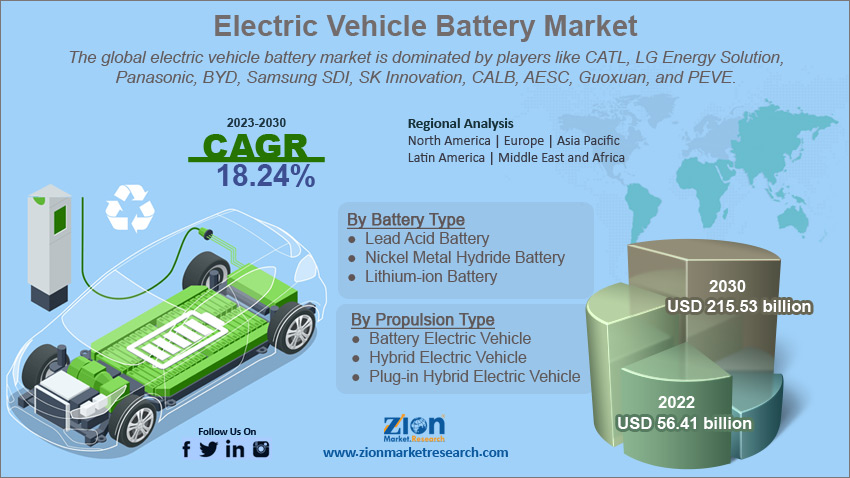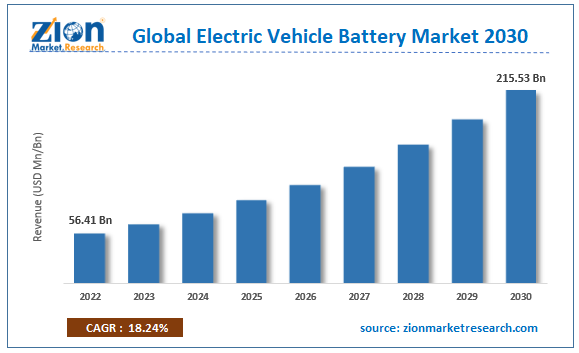Electric Vehicle Battery Industry Perspective:
The global electric vehicle battery market size was worth around $56.41 billion in 2022 and is predicted to grow to around $215.53 billion by 2030 with a compound annual growth rate (CAGR) of roughly 18.24% between 2023 and 2030.
The report analyzes the global electric vehicle battery market drivers, restraints/challenges, and the effect they have on the demands during the projection period. In addition, the report explores emerging opportunities in the electric vehicle battery industry.
Electric Vehicle Battery Market: Overview
An electric vehicle battery, also known as an EV battery, is a rechargeable energy storage device designed to power electric vehicles. This is a critical aspect of operating and powering electric cars, buses, vehicles, and other electric vehicles. EV batteries tend to be larger and consist of multiple cells, which affects the battery percentage. These batteries are typically lithium-ion (Li-ion) batteries, renowned for their high power density, performance, and durability. However, other battery chemistries, such as solid-state batteries, are also being developed for future electric vehicle (EV) applications. The battery percent serves as the number one supply of electrical power for the electrical vehicle, imparting power to the electric motor that drives the wheels. When the vehicle is in motion, the battery releases the stored energy in the form of strength, which powers the motor, allowing the car to transport.
Key Insights
- As per the analysis shared by our research analyst, the global electric vehicle battery market is estimated to grow annually at a CAGR of around 18.24% over the forecast period (2023-2030).
- In terms of revenue, the global electric vehicle battery market size was valued at around $ 56.41 billion in 2022 and is projected to reach $ 215.53 billion, by 2030.
- The electric vehicle battery market is experiencing an enormous boom due to rising government initiatives and incentives to inspire poeple to buy electric vehicles.
- Based on the battery type, the lithium-ion batteries segment is predicted to capture the largest market share during the forecast period.
- Based on the vehicle type, the passenger cars segment will grow at a significant rate during the forecast period.
- Based on the propulsion type, the battery-electric vehicles segment will grow at a significant rate during the forecast period.
- Based on region, North America is expected to dominate the market during the forecast period.
 Request Free Sample
Request Free Sample
Electric Vehicle Battery Market: Growth Drivers
Rising government initiatives and incentives to boost the global electric vehicle battery market growth
Governments are offering various economic incentives to inspire purchasers to buy electric vehicles. These incentives encompass rebates, grants, or tax credits that reduce the upfront costs of EVs, making them extra low-priced and attractive to potential consumers. The availability of such financial advantages is increasing the demand for electric cars and ultimately driving the demand for EV batteries. Governments provide tax concessions to increase the adoption of electrical vehicles. It focuses on setting up a large number of EV charging workstations and establishing strong charging infrastructure facilities to promote the growth of the electric vehicle sector and this, in turn, will increase EV battery sales. Growing renewable energy trends and the need for reducing fuel emissions in the environment will increase the scope of demand for electric vehicle batteries in the upcoming years.
Electric Vehicle Battery Market: Restraints
Limited range and charging infrastructure to restrict the global industry expansion
The availability and accessibility of charging stations are critical for the adoption of electric vehicles. Insufficient charging infrastructure, including both public and private charging points, can be a significant hindrance to the growth of the industry across the globe. Limited charging stations can lead to longer waiting times or the inconvenience of traveling long distances to find a charging point, making EVs a less feasible option for consumers. This will retard the growth of the electric vehicle battery industry across the globe.
Electric Vehicle Battery Market: Opportunities
Demand for Electric Commercial Vehicles (eCVs) to open new growth avenues for the global market
The expansion of the electrical industrial vehicles (eCVs) sector and the rise in the sale of electric vehicles will provide a substantial opportunity for the electrical vehicle battery market. Commercial cars, which include shipping vehicles, trucks, buses, and fleet motors, are essential for numerous industries, along with logistics, transportation, and public transit. The shift closer to electrifying those industrial vehicle segments gives several benefits, such as decreased emissions, a decline in expenses, and advanced sustainability. The electrification of commercial vehicles calls for superior EV battery technologies that could meet the demand for heavy-responsibility programs, inclusive of longer use levels, higher strength garage capacities, and fast charging abilities. The EV battery marketplace stands to benefit from the growing demand for batteries that could energy eCVs successfully and reliably.
Electric Vehicle Battery Market: Challenges
Limited charging infrastructure can prove to be a major challenge to the global industry surge
Inadequate charging infrastructure hinders the growth of the global electric vehicle battery industry. The availability and accessibility of charging stations play a critical function in the convenience and practicality of proudly owning an electric vehicle. The limited number of charging stations, mainly in rural or less populated regions, creates range tension and limits the willingness of customers to replace electric vehicles. This limitation can hinder the growth of the industry.
Electric Vehicle Battery Market: Segmentation
The global electric vehicle battery industry is segmented based on battery type, vehicle type, propulsion type, and region. `
Based on its battery type, the global electric vehicle battery market is bifurcated into lead acid batteries, nickel metal hydride batteries, and lithium-ion batteries segments. The lithium-ion batteries segment is predicted to capture the largest market share during the forecast period. The rising use of electric cars can be the major boom component for lithium-ion batteries. With the government’s global push for decarbonization and customers’ awareness toward the green environment, the transition in the direction of electric-powered motors is accelerating. Lithium-ion batteries are the favored choice for electric cars due to their high electricity density, longer riding tiers, and improved performance compared to other battery technologies. The growing adoption of electric automobiles directly translates into growing demand for lithium-ion batteries. This lithium-ion batteries segment boosts the growth of the global industry.
Based on the vehicle type, the global electric vehicle battery industry is divided into passenger cars, commercial vehicles, and two-wheelers segments. The passenger cars segment is expected to dominate the global industry over the forecast period. As the demand for cleaner and more sustainable transportation solutions increases, electric-powered passenger cars have gained traction as a viable alternative to standard inner combustion engine vehicles. The development and adoption of advanced battery technology had been instrumental in making electric-powered cars greater practical and attractive to customers.
Based on the propulsion type, the global electric vehicle battery market is divided into battery electric vehicles, hybrid electric vehicles, and plug-in hybrid electric vehicles segment. The battery-electric vehicles segment is expected to dominate the market over the forecast period. Growing environmental concerns, including climatic changes and air pollution, have increased the demand for zero-emission vehicles such as pure electric vehicles. Governments around the world are implementing stringent emissions regulations and setting targets to reduce greenhouse gas emissions. Incentives, subsidies, and stricter emissions standards for conventional vehicles are driving consumers and automakers to switch to pure electric vehicles and boost their growth.
Recent Developments:
- In February 2023, CATL, the world’s leading EV battery manufacturer, acquired Nexeon, a German battery technology company. The acquisition will give CATL access to Nexeon’s lithium-sulfur battery technology, which has the potential to offer longer range and faster charging than traditional lithium-ion batteries. This acquisition can boost the growth of the industry.
- In March 2023, SK On, a South Korean battery manufacturer, acquired Solid Power, a US-based company developing solid-state battery technology. The acquisition will give SK On access to Solid Power’s technology, which is seen as a potential next-generation battery technology with the potential to offer longer range, faster charging, and greater safety than traditional lithium-ion batteries. This acquisition can boost the growth of the industry.
Electric Vehicle Battery Market: Report Scope
| Report Attributes | Report Details |
|---|---|
| Report Name | Electric Vehicle Battery Market Report |
| Market Size in 2022 | USD 56.41 Billion |
| Market Forecast in 2030 | USD 215.53 Billion |
| Growth Rate | CAGR of 18.24% |
| Number of Pages | 212 |
| Key Companies Covered | CATL, LG Energy Solution, Panasonic, BYD, Samsung SDI, SK Innovation, CALB, AESC, Guoxuan, and PEVE. |
| Segments Covered | By Battery Type, By Vehicle Type, By Propulsion Type, and By Region |
| Regions Covered | North America, Europe, Asia Pacific (APAC), Latin America, Middle East, and Africa (MEA) |
| Base Year | 2022 |
| Historical Year | 2017 to 2021 |
| Forecast Year | 2023 – 2030 |
| Customization Scope | Avail customized purchase options to meet your exact research needs. Request For Customization |
Electric Vehicle Battery Market: Regional Analysis
North America is expected to dominate the global market during the forecast period
North America is predicted to dominate the global electric vehicle battery market. Government subsidies and tax credits have promoted the adoption of electric vehicles and this has created huge demand for electric vehicle batteries. These incentives, along with stringent emission rules and zero-emission targets, encourage customers to adopt electric-powered vehicles. The rapid growth of charging infrastructure is a key driving factor in North America. Governments, utilities, and private organizations are investing in the set-up of public charging stations, rapid-charging networks, and domestic charging solutions, improving the benefit and accessibility of charging for electric vehicle owners. North America was the largest market for EV batteries in 2022, accounting for around 40% of the global market share.
The European industry is predicted to record the highest CAGR over 2023-2030. Europe is thought for its stringent emission regulations and environmental goals. These rules push automakers to produce more electric-powered vehicles to meet zero-emission requirements. The regulatory surroundings act as a sturdy driver for the electric vehicle sector in Europe, thereby promoting the growth of the electric vehicle battery industry in the continent. Various European countries provide economic incentives, grants, and tax benefits to manufacturers for encouraging the sale of electric automobiles. These incentives, coupled with an increasing focus on environmental sustainability, will drive client demand for electric vehicle batteries.
Electric Vehicle Battery Market: Competitive Analysis
The global electric vehicle battery market is dominated by players like:
- CATL
- LG Energy Solution
- Panasonic
- BYD
- Samsung SDI
- SK Innovation
- CALB
- AESC
- Guoxuan
- PEVE.
The global electric vehicle battery market is segmented as follows:
By Battery Type
- Lead Acid Battery
- Nickel Metal Hydride Battery
- Lithium-ion Battery
By Vehicle Type
- Passenger Car
- Commercial Vehicle
- put-Wheeler
By Propulsion Type
- Battery Electric Vehicle
- Hybrid Electric Vehicle
- Plug-in Hybrid Electric Vehicle
By Region
- North America
- The U.S.
- Canada
- Europe
- France
- The UK
- Spain
- Germany
- Italy
- Rest of Europe
- Asia Pacific
- China
- Japan
- India
- South Korea
- Southeast Asia
- Rest of Asia Pacific
- Latin America
- Brazil
- Mexico
- Rest of Latin America
- Middle East & Africa
- GCC
- South Africa
- Rest of Middle East & Africa


